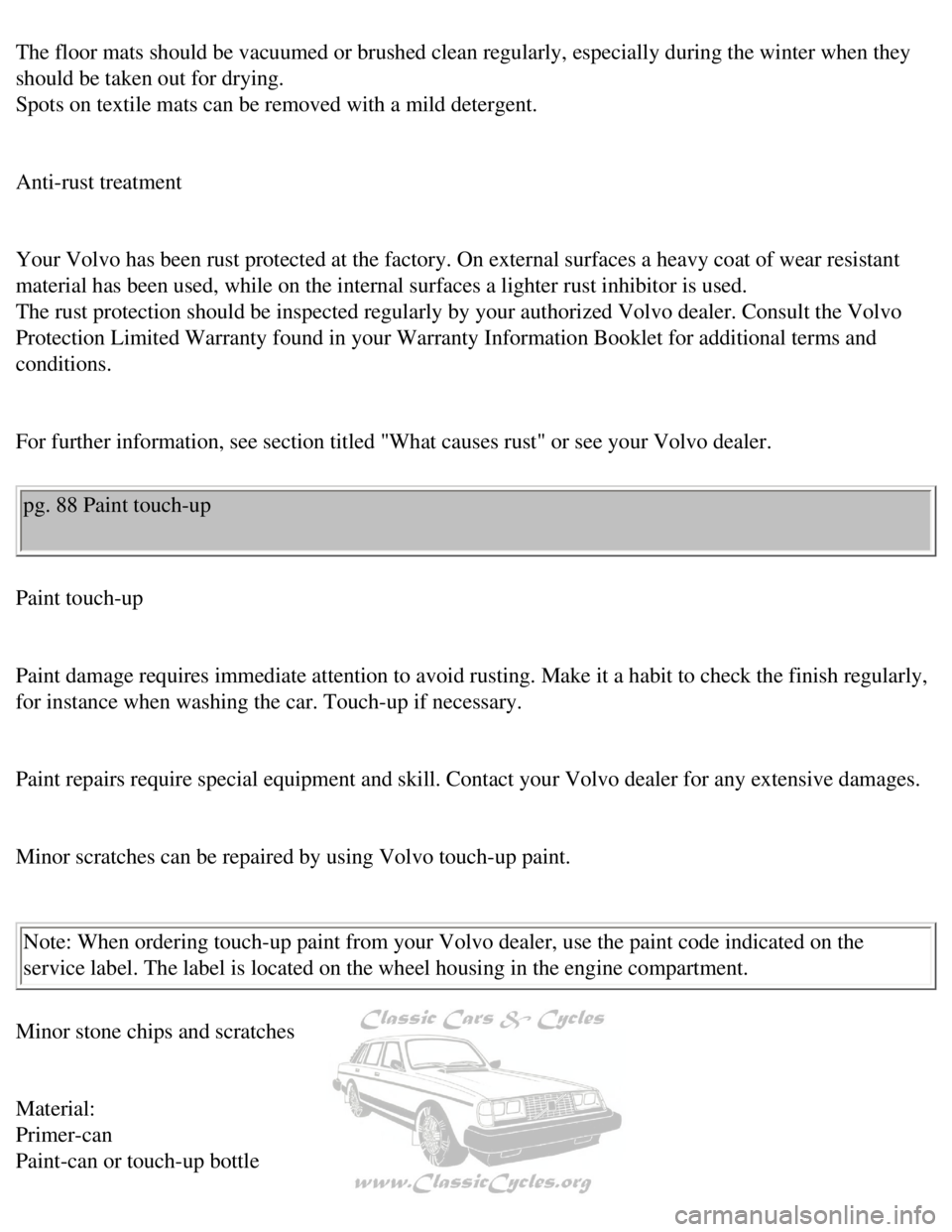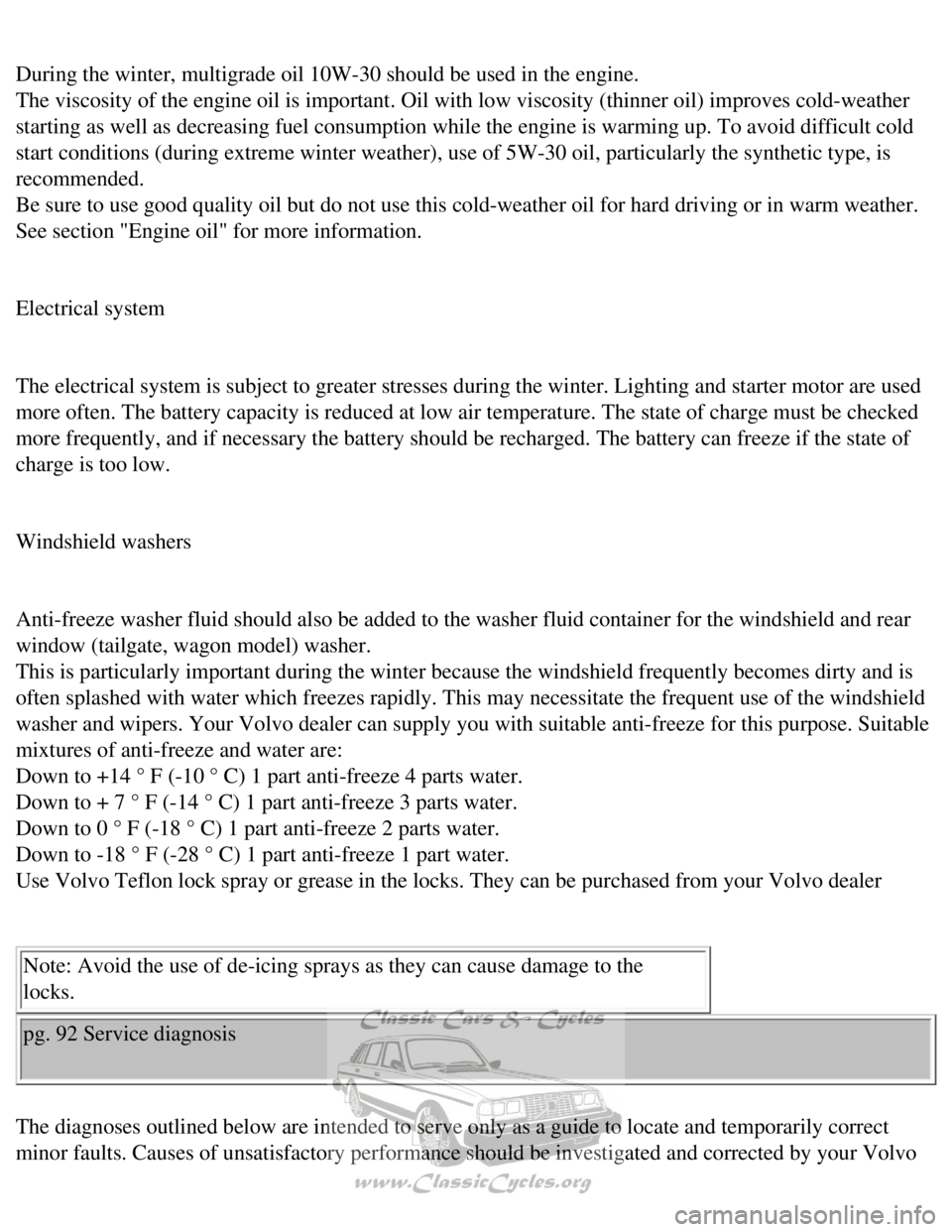Page 102 of 143
Volvo 1990 240 Model
WARNING!
To prevent possible explosion, never expose battery to open flame or ele\
ctric spark. Do not smoke
near battery. Batteries generate hydrogen gas which is flammable and exp\
losive.
Battery fluid contains sulfuric acid which can cause serious injury.
Do not allow battery acid to contact eyes, skin, fabrics or painted surf\
aces. If contact occurs,
thoroughly flush affected area immediately with water.
Obtain medical attention immediately if eyes are affected.
After engine has started first remove negative (-) jumper cable, then \
positive (+) terminal jumper cable.
Contents | Top of Page
file:///K|/ownersdocs/1990/1990_240/90240_15.htm (10 of 10)12/30/2006 \
8:25:09 AM
Page 103 of 143
Volvo 1990 240 Model
pg. 76 Replacing bulbs
Replacing bulbs
The replacement of bulbs in the various lighting units is shown on the f\
ollowing pages. Make sure when
installing bulbs, that the guide pin on the socket fits into its corresp\
onding recess.
When installing bulbs, do not touch the glass with your fingers. The rea\
son for this is that grease, oil or
any other impurities can be carbonized onto the bulb and damage the refl\
ector.
Use bulbs of correct type and voltage. Failure to do so could activate t\
he bulb failure warning light.
Replacing headlight bulbs
Working inside the engine compartment, separate the socket contact from \
the bulb holder (1). Unscrew
and remove the bulb holder retaining ring (2) Pull out the bulb holder\
assembly, and replace it as a unit
(3).
Installation is the reverse of removal.
Check headlight alignment.
Bulb Power Trade No.
Headlamp 45/65W 9004
file:///K|/ownersdocs/1990/1990_240/90240_16.htm (1 of 10)12/30/2006 8\
:25:10 AM
Page 110 of 143
Volvo 1990 240 Model
stop light pg. 80 Replacing bulbs
Interior light
Insert a screwdriver through the opening in the right side of the housin\
g and depress the catch tab. Pull
out the housing assembly and replace the bulb.
Bulb Power Socket
Interior light 10 W S 8.5 - 8
Engine compartment light, Trunk light
file:///K|/ownersdocs/1990/1990_240/90240_16.htm (8 of 10)12/30/2006 8\
:25:10 AM
Page 111 of 143
Volvo 1990 240 Model
Remove screw holding the light assembly Lift it out to remove.
Replace the bulb.
Reinstall by first inserting the guides into one side, then press ir, th\
e light assembly and install the screw.
Bulb Power Socket
Engine compartment light 15 W S 8.5 - 8
Trunk light 15 W S 8.5 - 8
Instrument and heater control lighting
Due to the location of these bulbs their replacement should be carried o\
ut by a Volvo dealer. pg. 81 Fuses
Replacing fuses
The fuse box is positioned in front of the left front door pillar. When \
replacing fuses, check that the
correct amperage is used.
Never use fuses of higher amperage. unless specified by your Volvo deale\
r. If one fuse repeatedly fails,
take the car to your Volvo dealer for fault tracing.
A spare fuse kit is available from your Volvo dealer.
file:///K|/ownersdocs/1990/1990_240/90240_16.htm (9 of 10)12/30/2006 8\
:25:10 AM
Page 118 of 143

Volvo 1990 240 Model
The floor mats should be vacuumed or brushed clean regularly, especially\
during the winter when they
should be taken out for drying.
Spots on textile mats can be removed with a mild detergent.
Anti-rust treatment
Your Volvo has been rust protected at the factory. On external surfaces \
a heavy coat of wear resistant
material has been used, while on the internal surfaces a lighter rust in\
hibitor is used.
The rust protection should be inspected regularly by your authorized Vol\
vo dealer. Consult the Volvo
Protection Limited Warranty found in your Warranty Information Booklet f\
or additional terms and
conditions.
For further information, see section titled "What causes rust" or see yo\
ur Volvo dealer. pg. 88 Paint touch-up
Paint touch-up
Paint damage requires immediate attention to avoid rusting. Make it a ha\
bit to check the finish regularly,
for instance when washing the car. Touch-up if necessary.
Paint repairs require special equipment and skill. Contact your Volvo de\
aler for any extensive damages.
Minor scratches can be repaired by using Volvo touch-up paint.
Note: When ordering touch-up paint from your Volvo dealer, use the paint\
code indicated on the
service label. The label is located on the wheel housing in the engine c\
ompartment.
Minor stone chips and scratches
Material:
Primer-can
Paint-can or touch-up bottle
file:///K|/ownersdocs/1990/1990_240/90240_18.htm (4 of 8)12/30/2006 8:\
25:11 AM
Page 123 of 143

Volvo 1990 240 Model
pg. 91 Long distance trips, Cold weather
Prior to a long distance trip
Have your car checked at a Volvo dealer. Preventive maintenance will hel\
p to ensure a trouble free trip.
Remember to take along a Volvo dealer directory.
The main items to check are listed below:
1. Brakes, front wheel alignment and steering gear.
2. Engine running condition.
3. Fuel system operation.
4. Oil leaks: engine, transmission, rear axle.
5. Cooling system for leaks or worn hoses.
6. Examine tires carefully, replace worn tires.
7. Battery and terminals.
8. Tool equipment.
9. Lighting.
10. Drive belts, for tightness and wear.
11. All fluid levels.
Cold weather/Engine fuel system
During the winter, large variations in temperature cause condensation to\
form in the fuel tank and can
impair the running of the engine. This can be reduced by adding dry gas \
to the fuel. There is less risk of
condensation forming in the fuel tank if it is kept full or nearly full.\
Engine cooling system
Volvo type C (blue-green) coolant should be used all year round. The c\
ooling system should always
contain water plus anti-freeze and rust inhibitor, even during the summe\
r. Experience has also shown
that extremely weak anti-freeze solutions (10-25 percent) are ineffect\
ive for rust protection. For this
reason, the quantity of antifreeze/summer coolant should be about 50 per\
cent of the solution. This
lowers the freezing point to - 30 ° F (-35 ° C).
Engine lubricating system
file:///K|/ownersdocs/1990/1990_240/90240_19.htm (1 of 7)12/30/2006 8:\
25:13 AM
Page 124 of 143

Volvo 1990 240 Model
During the winter, multigrade oil 10W-30 should be used in the engine. \
The viscosity of the engine oil is important. Oil with low viscosity (t\
hinner oil) improves cold-weather
starting as well as decreasing fuel consumption while the engine is warm\
ing up. To avoid difficult cold
start conditions (during extreme winter weather), use of 5W-30 oil, pa\
rticularly the synthetic type, is
recommended.
Be sure to use good quality oil but do not use this cold-weather oil for\
hard driving or in warm weather.
See section "Engine oil" for more information.
Electrical system
The electrical system is subject to greater stresses during the winter. \
Lighting and starter motor are used
more often. The battery capacity is reduced at low air temperature. The \
state of charge must be checked
more frequently, and if necessary the battery should be recharged. The b\
attery can freeze if the state of
charge is too low.
Windshield washers
Anti-freeze washer fluid should also be added to the washer fluid contai\
ner for the windshield and rear
window (tailgate, wagon model) washer.
This is particularly important during the winter because the windshield \
frequently becomes dirty and is
often splashed with water which freezes rapidly. This may necessitate th\
e frequent use of the windshield
washer and wipers. Your Volvo dealer can supply you with suitable anti-f\
reeze for this purpose. Suitable
mixtures of anti-freeze and water are:
Down to +14 ° F (-10 ° C) 1 part anti-freeze 4 parts water.
Down to + 7 ° F (-14 ° C) 1 part anti-freeze 3 parts water.
Down to 0 ° F (-18 ° C) 1 part anti-freeze 2 parts water.
Down to -18 ° F (-28 ° C) 1 part anti-freeze 1 part water.
Use Volvo Teflon lock spray or grease in the locks. They can be purchase\
d from your Volvo dealer
Note: Avoid the use of de-icing sprays as they can cause damage to the
locks.
pg. 92 Service diagnosis
The diagnoses outlined below are intended to serve only as a guide to lo\
cate and temporarily correct
minor faults. Causes of unsatisfactory performance should be investigate\
d and corrected by your Volvo
file:///K|/ownersdocs/1990/1990_240/90240_19.htm (2 of 7)12/30/2006 8:\
25:13 AM
Page 125 of 143

Volvo 1990 240 Model
dealer.
Condition: Starter fails to operate (or operates very slowly)
Possible cause Correction
Weak battery or dead cell. With the starting (ignition) switch in the "Driving"
or "On" position, check to see if the warning lights
on the dashboard come on and if they stay on when
the starter is engaged. If the lights do not come on or
if they go off when the starter is engaged, the battery
is discharged or see below.
Loose or corroded battery cable terminals. Check battery terminals and clamps. Clean or
replace if necessary. Check that the starter cable is
secure at its terminals.
The ground strap, which connects the battery
negative (-) terminal to the engine, should also be
checked for corrosion or looseness.
Open circuit between starting (ignition) switch
and starting (ignition) switch terminal on
starter. The circuit is closed if a clicking sound is heard
from the starter when it is engaged. If no clicking
sound is heard, check that the blue wire at the starter
is secure. If still no clicking sound is heard, the
starting (ignition) switch or the wire is defective.
Starter motor defective. If the above checks have been performed, and no
fault is evident, the starter may be defective. NOTE:
In this case the headlight intensity will not dim when
the starter is engaged.
pg. 93 Service diagnosis
Condition: Starter motor operates but engine does not start
file:///K|/ownersdocs/1990/1990_240/90240_19.htm (3 of 7)12/30/2006 8:\
25:13 AM